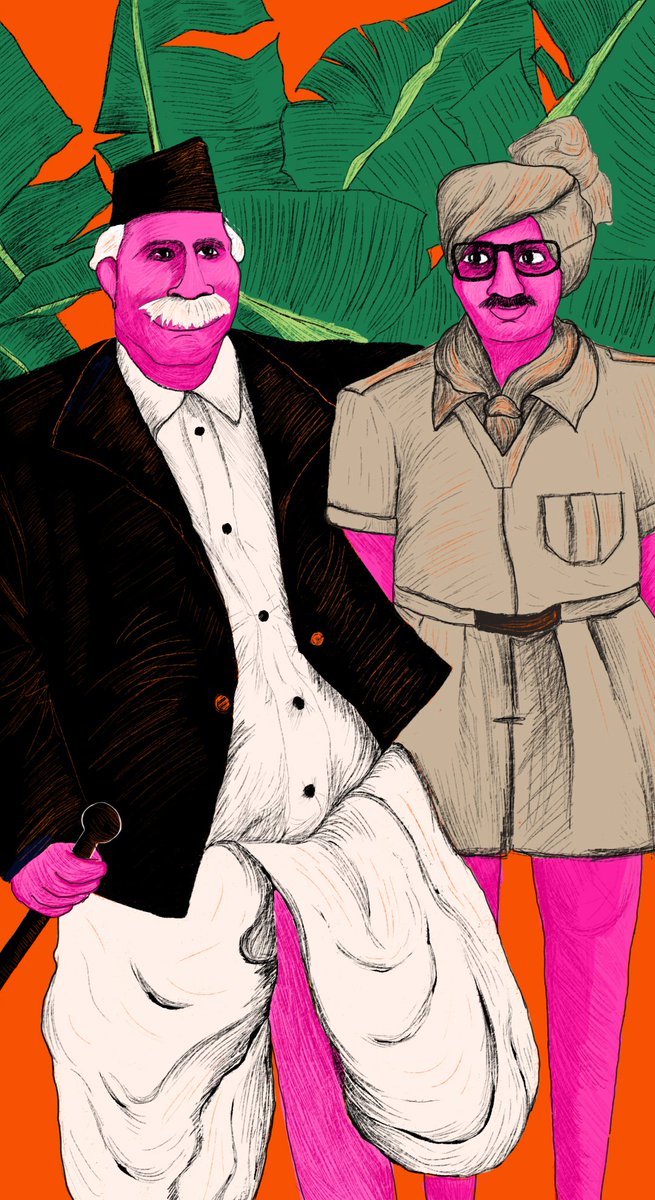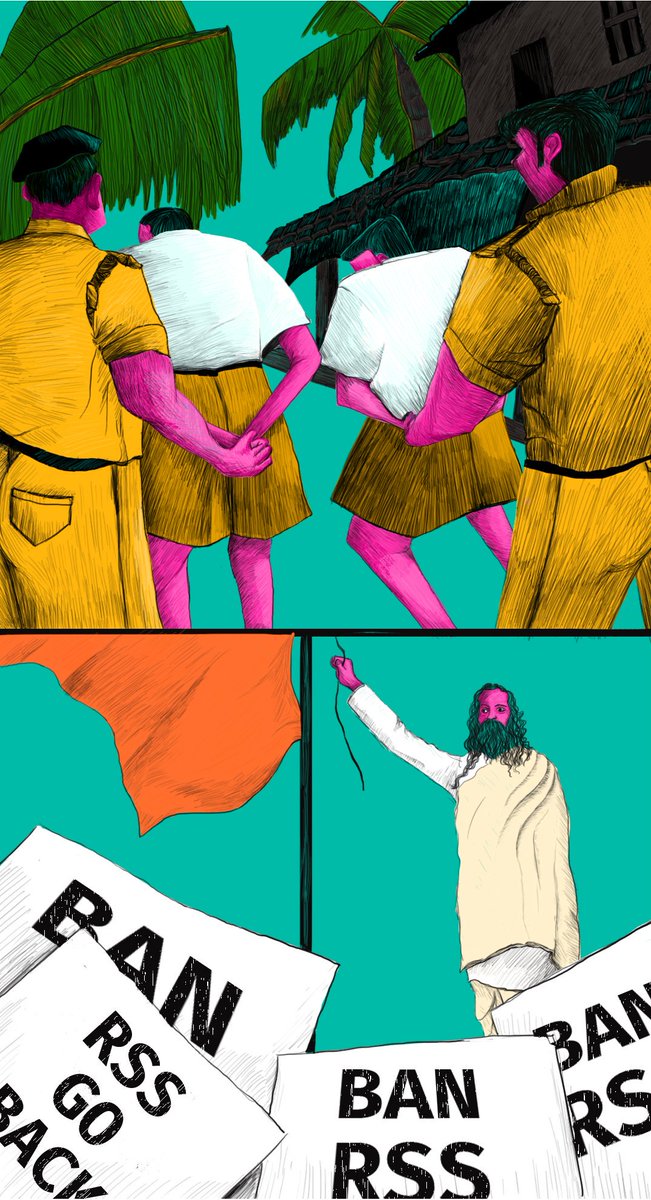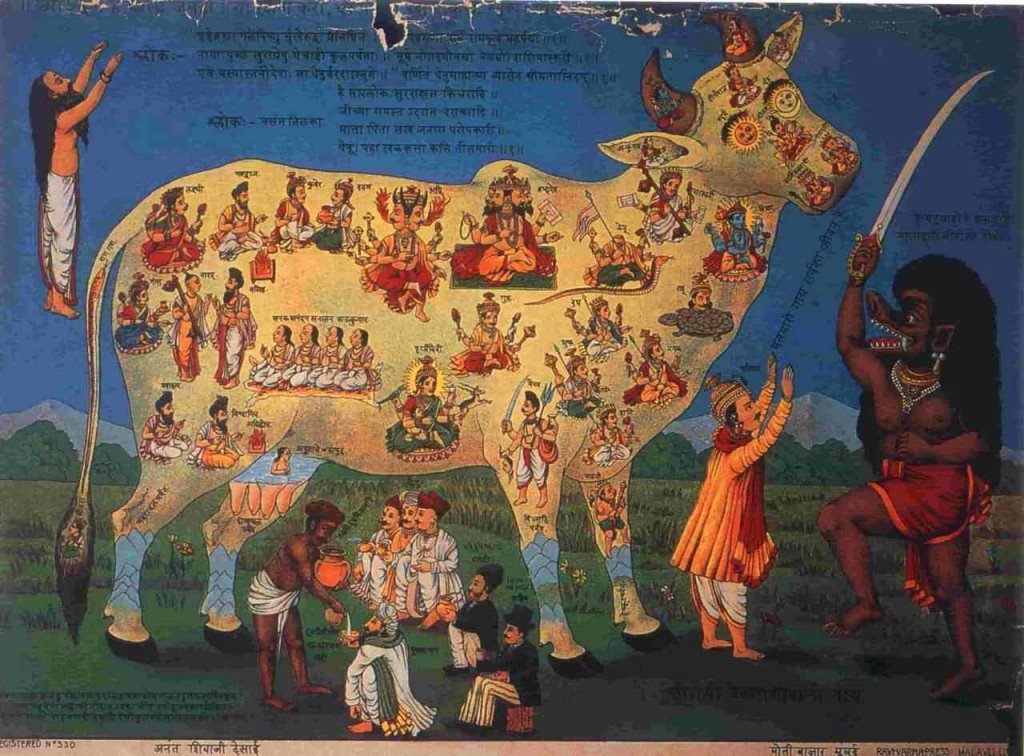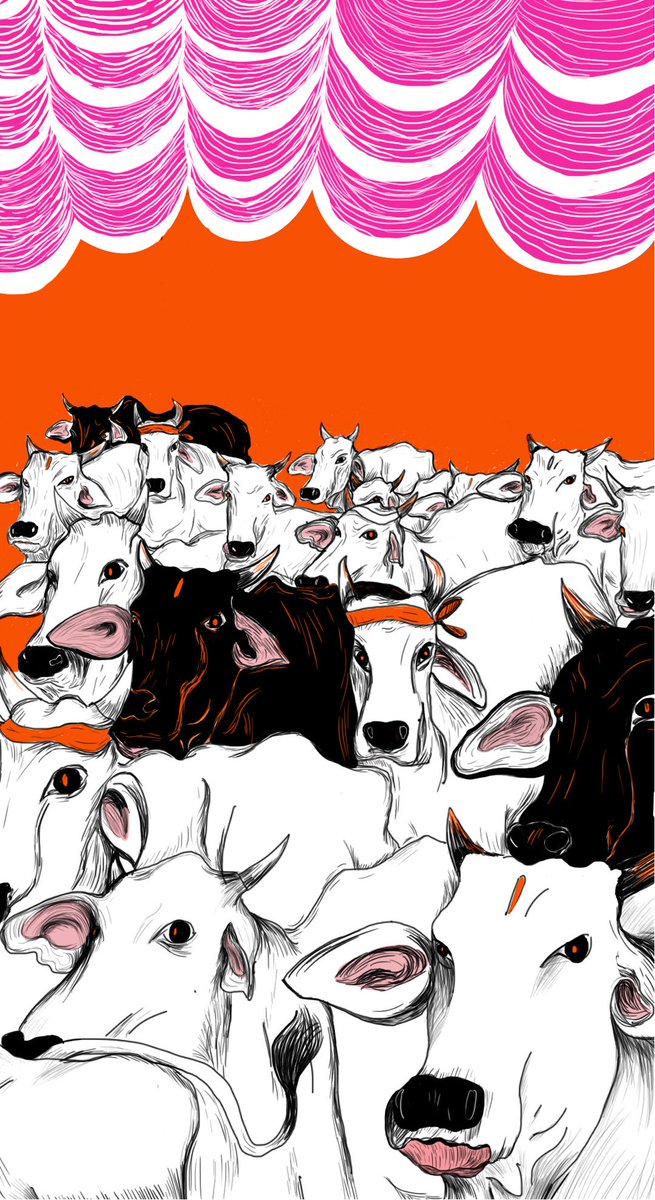I will share one piece from my Coastal Karnataka series everyday and I urge those from the region to share this. I am open to engaging and discussing about this in a civil manner. If you want to blow your top, sure go ahead and watch me show you the middle finger
This series is about how Coastal Karnataka was saffronised. It contains 18 articles and there is a sequence to it, if you read closely. It involves months of interviews and digging up archival material. It also involves tremendous patience/support from my Editor who is the best
In the opener, I argue that to understand Hindu Nationalism in DK, we should look beyond what has happened in the past few decades. We should go back to the ones who pioneered Hindu Nationalism here in the 1800s - the Saraswat Brahmins. https://www.firstpost.com/india/how-coastal-karnataka-was-saffronised-the-story-of-the-rise-and-rise-of-hindu-nationalism-in-syncretic-south-kanara-6363461.html
1. Before the founder of RSS Hedgewar passed away, Sanjeeva Kamath - a GSB from DK met him in Nagpur. The RSS then networks with Kamath and his contacts from DK following which the first shaka was set up in Sep 1940 at the Canara High School grounds. https://www.firstpost.com/politics/how-coastal-karnataka-was-saffronised-part-1-hedgewar-sends-an-emissary-to-mangalore-a-shakha-is-born-the-rss-takes-root-6364981.html
My series is all the more exciting because of my thangi-in-arms @srujangatha who I love to bits. She has created some brilliant illustrations for this series. The first one depicts this meeting between Hedgewar and Kamath. FYI Shrujana is the BEST
2.The first 'Hindu' mobilisation was in 1870, 70 years before the RSS set up its 1st shakha in Mangaluru - this had nothing to do with Hindu nationalism. It was a reaction of the Saraswat Brahmins to the conversion of their ilk to Christianity. https://www.firstpost.com/india/how-coastal-karnataka-was-saffronised-part-2-arya-samaj-picks-up-hindu-nationalism-after-brahmo-samaj-fails-to-unite-local-communities-6372841.html
The other lowered castes, such as the Billavas had already converted by then. Their conversions didn't evoke any response from Brahmins. It instead attracted their antagonism as Billavas started enrolling in Basel Mission's English medium school and working with the British govt.
The literal meaning of the word 'Billava' is archer. The revered Tuluva warriors Koti and Chennaya, belong to the Billava community. Billavas are numerically the largest Tulu speaking group in South Kanara.
Billavas, the 1st lowered caste group to take to education in SK - in spite of protests against their entry. In 2 decades after the 1st generation of Billavas were educated in the Basel Mission School, they started sharing offices with Brahmins who considered them untouchables.
In 1851, the Brahmins, who were the largest group in government service, petitioned the district judge in Mangaluru against the employment of Billavas as trainees in the East India Company.
The petition stated, "In the course of time Billavas would become the heads of the offices and Brahmins would be compelled to obey their orders, the orders of people that they could scarcely look at without being polluted."
This Brahmin resentment towards their education-enabled success turned the Billavas more militant and they gravitated towards Christianity. The period between 1869 and 1875 saw many lowered castes. This exodus came to be known later as the Basel Mission's 'Tulu movement'.
While the conversion of these communities attracted little attention from the dominant Gaud Saraswat Brahmins, it was the only conversion of their own men which pushed them to come together. This is the history of the first 'Hindu' or actually Brahmin mobilisation in South Kanara
They petitioned the British for a seperate school opposing the Basel Mission's school (which was a site of 'impurity' for them) which they fundraised for and eventually built. This is depicted in the below illustration by @srujangatha
Read further to understand how the Brahmo Samaj was invited in the same year. Read why they flopped and how Arya Samaj tried to incorporate the learning from the Brahm Samaj failure subsequently.
I've shared what's enough to make y'all curious, so all of you better go READ or else I'll be pissed and sad and angry. Saying RSS RSS isn't enough, we need to educate ourselves about everything that has happened. So go read NOW.
I got this DM: 'Focus on imp issues, why writing about RSS'.
I wrote it for the sake of my lover (who I haven't found) and my children (who I haven't had) and my friends and their children and more people and everybody. For reasons I can't think of but that's okay. Stfu and read
I wrote it for the sake of my lover (who I haven't found) and my children (who I haven't had) and my friends and their children and more people and everybody. For reasons I can't think of but that's okay. Stfu and read
3. Background: In the early 1900s, there were three major Hindu formations in the North: the Brahmo Samaj, the Arya Samaj and a loose collection of orthodox traditionalists who believed in Sanatana Dharma, which is mainly keeping caste as is. https://www.firstpost.com/india/how-coastal-karnataka-was-saffronised-part-3-hindu-groups-organise-hindu-rashtra-is-defined-savarkar-makes-his-mark-6381771.html
Their activities fell within the realm of the slowly emerging construct of 'Hindu nationalism', promulgated mostly by Brahmins, the first of them being Raja Ram Mohan Roy from Calcutta.
Roy argued that ancient Vedic religion was superior to others including Christianity and that oppressive practises were newer additions. After him came Dayanand Saraswati who founded the Arya Samaj.
Saraswati argued that "Aryas" formed Bharat and were spiritually/socially/culturally superior. Rather than reform, a revival was in order to restore 'Bharat' to its erstwhile glory. He was the 1st person to justify caste system as an egalitarian 'merit based division of labour'.
The reformists, revivalists and sanatanists articulated differently but it all came down to the same point - it started at reform and swung to the revival of a "glorious Vedic past". They put their differences aside and came together in 1915 as the All India Hindu Mahasabha. Why?
I won't say why. Read my piece, you'll know. Clue: Morley-Minto Reforms.
Meanwhile, in Coastal K, the Hindu movement was still finding its feet, with the Arya Samaj and Brahmo Samaj focussed on the threat that Christian conversions posed to the supremacy of the various Brahmin castes. Around the same time, Savarkar is in jail contemplating 'life'.
From an anti-British activist, he turns into an anti-Muslim activist. In 1920, he wrote 'Hindutva: Who is a Hindu?' as a counter to the mobilisation of Muslims in India around the issues of separate electorates and the Ottoman Khilafat.
He was the first to define 'Hindu Rashtra' as 'Hindu, Hindi, Hindustan' — a geographical territory of Hindustan where the majority Hindu community resides.
Savarkar's idea was so influential that it was instantly accepted as a rallying cry by the organisations rushing under the Hindu Mahasabha's umbrella. The forefathers of this community, Savarkar said, were Vedic Aryans.
He went on to say that before the invasion of Muslims and 'forcible conversions' to Islam, Hindustan existed as a "glorious" nation. All Indian Muslims and Christians he said were originally Hindu, their conversion had changed their allegiance to Mecca or Palestine.
Savarkar said Hindus were bound by their cultural identity which stemmed from immersion in Vedic Sanskritic codes. He said 'Hindutva' is deeper than just Hinduism. After he was released by the British, Savarkar was quarantined in Ratnagiri - barred from political activity.
In 1937, when he was finally allowed to leave Ratnagiri, he moved to Bombay and was elected President of the Hindu Mahasabha. When World War II broke out, he honoured his pledge of loyalty to the British by organising his cadre to join the allied army.
In 1933, the Akhila Bharatiya Hindu Mahasabha organised its first mass meeting in South Kanara at Mundajje village 70 km from Mangalore. The chief guest was RG Bhide. He was the chief editor of Kesari, the newspaper founded by Tilak and the general secretary of the Mahasabha.
A sense of how profoundly Savarkar's ideas in his book 'Hindutva: Who is a Hindu' had shaped the thinking of the Hindu leaders of the time can be assessed from the speech Bhide delivered at Mundajje. Read the full translated speech of Bhide here: https://www.firstpost.com/india/how-coastal-karnataka-was-saffronised-part-3-hindu-groups-organise-hindu-rashtra-is-defined-savarkar-makes-his-mark-6381771.html
4. The Mahasabha tried unsuccessfully to organise in DK but it couldn't achieve much success. At the time, the Mahasabha's anti-Muslim discourse was popular mainly in North India. Close on their heels, the RSS arrived in Mangalore in 1941. https://www.firstpost.com/india/how-coastal-karnataka-was-saffronised-part-4-rss-banned-golwalkar-forms-vhp-recruits-vishvesha-teertha-of-pejavara-mutt-6387561.html
The RSS in Mangalore was initially confined to GSB strongholds such as Pentlendpet/Car Street, the same neighbourhoods that birthed the Arya Samaj & the Brahmo Samaj. Public meetings of the RSS were held at its birthplace, the Canara High School in Mangalore.
MS Golwalkar's hopes from the unit can be gauged from his regular visits to Mangalore after the organisation was formed in 1941. All his visits started with a visit to the Venkatramana Temple on Car Street, the main centre of the Gaud Saraswat Brahmin community's faith.
Local organisations such as the Jaathiytha Virodha Sanyuktha Sangha and Anti-Fascists United League countered the progress of the RSS by organising rallies, using terms such as 'casteist'/'communal' to describe the Sangh. They blamed the Congress of being soft towards the RSS.
There was very little political space at the time for the RSS to grow as Mangalore was a Congress stronghold, and leadership of the party was shared among others, by Gaud Saraswat Brahmins and the Bearys.
This political alliance between the Gaud Saraswat Brahmins and Bearys, otherwise rivals in every sphere, emerged in the Congress as a result of the visit of Mohandas Karamchand Gandhi and Moulana Shaukat Ali in 1920. This alliance hampered the growth of the RSS for a while.
Golwalkar struggled to find takers for his organisation in the coast. When five lakh Dalits were converted to Buddhism under the leadership of Dr BR Ambedkar in 1956, conversion as a means to escape caste inequalities inherent to Hinduism resurfaced as a strategy.
Hindu nationalists tried various attempts to salvage the situation in 1964. One such attempt was the formation of the Vishwa Hindu Parishad. Golwalkar was averse to political participation. Instead, he envisioned a mega national project to enlist religious heads to action.
In coastal Karnataka, Golwalkar recruited Vishvesha Teertha - the seer of the Pejavara Adokshaja Mutt. The Krishna mutt is the most powerful of the eight such monasteries in the temple town of Udupi which has drawn Brahmin pilgrims from across the country for centuries.
Now 87, Teertha rose to become a key player from the South in the Ram Janmabhoomi campaign. In the late 1940s and 50s, Teertha mainly campaigned on building an opinion against religious conversions of lowered caste Hindus.
Ironically, to this day, Dalits and other non-Brahmin castes are not allowed into the sanctum sanctorum and the dining area of the Pejavara seer's (Vishvesha Teertha) own monastery.
A measure of the local Brahmin community's rigidity can be gauged from the fact that the Krishna Mutt has a powerful anti-caste legend set in the medieval era - (Kanakadasa's story)
The 'Dalit household entry' campaign that the Sangh praises Teertha for, this is what a senior leader of the Dalit Sangarsha Samiti (DSS), M. Devadas has to say about it:
"My father invited Teertha in 1962 for the inauguration of a community hall in Bajpe. The program consisted of felicitating achievers where the women would spread out their pallus in front of the Swamy and he would drop the awards from above without touching the awardees."
M. Devdas says that most Dalit organisations would invite the Pejavar seer for their programs as he was known as the 'liberal Swamy' but this kind of contradiction was visible as well.
The 1920s, as we have seen, belonged entirely to Gandhi and the Congress. Between 1921 and 1935, Gandhi visited Mangalore thrice; the region was bristling with anti-British nationalist fervour.
In line with their national leadership, which in the 1940s sided with the British, the coastal leaders of the Hindu-right, too, stayed out of the freedom struggle as well as the other movements such as land reforms and tenancy rights that were mustering support for the Congress.
The RSS, apart from organising programs for their national leaders like Golwalkar were mainly strategising on expansion. They hardly had any direct involvement in the freedom struggle. A few RSS leaders and cadre in the region participated individually.
Under the leadership of RSS Mangalore head HV Sheshadri, his recruits started setting up shakhas in urban Mangalore and smaller towns like Udupi, Puttur and Karkala.
In the bordering town of Puttur, the credit of expanding the RSS shakha network goes to the areca nut-farming community of the Havyak Brahmins. Urimajalu Ram Bhat, 92 is one of the early leaders from here who can be credited for the initial work of the Sangh in the region.
Ram Bhat recounts attending the first RSS statewide youth camp in Bangalore in 1948. "The Chief Minister of Mysore Presidency K Chengalaraya Reddy attended the camp and stayed with us. There were more than 5,000 of us from all parts of the state."
This surge in membership quickly vanished in the months following the killing of Gandhi by Nathuram Godse a Hindu extremist. The RSS was banned even though they said that Godse had quit the organisation before the assassination.
Bhat and 45 other RSS workers were arrested for holding protests against the RSS ban. When the ban was lifted in July 1949, despite huge resistance Golwalker came back to Mangalore and hoisted the National Flag at 'Sanghniketan', the RSS headquarters at Pentlendpet.
Incidentally, Gandhi had conducted meetings just a few blocks away from where Sanghaniketan stands today. Though natural, what is ironical is that the RSS started its HQ in the same area that once served as a refuge for Congressmen and leaders of the freedom struggle.
RSS workers being arrested, Golwalkar hoists their flag in Mangalore after the ban on RSS is lifted. The brilliance of
@srujangatha on display agaaain.
@srujangatha on display agaaain.
5. GAU-HATYA. GAU-RAKSHA. If you are from DK, you'll hear this everyday. You would have heard of the murders that took place in the name of the COW. I have devoted two full articles to breakdown how political 'GAU RAKSHA' came to be. Take a look. https://www.firstpost.com/india/how-coastal-karnataka-was-saffronised-part-5-gauraksha-goes-mainstream-hindu-groups-launch-national-cow-weekly-in-udupi-6395801.html
Gauraksha received a fresh lease of life in the communal north provinces when Dayanand Saraswati published a book on the protection of cows called 'Gaukarunanidhi' in 1881. In the book, while squarely blaming Muslims (incorrectly, both historically and factually), Saraswati says:
"It was during the last 700 years that flesh eating foreign races who started slaughter of cow and other animals came in considerably number and inhabited India. They eat away flesh and bones of all these beneficent animals."
Saraswati recommended setting up of Gorakshak Sabhasads to work towards protecting the animal. As commanded by their leader, Arya Samajists set up such societies across, especially in the Punjab-Sindh region, where gau-related violence can be traced back to the 1850s.
Regular public campaigns calling on 'Hindu protecters' to protect the 'sacred cow' against 'beef-eating Muslim invaders' in the north were organised. Handbills regarding cow slaughter were printed and distributed along with newspapers, like this one which is a Ravi Verma product
This model of gauraksha emerged in coastal Karnataka as a popular method to homogenise the native population only a century after Saraswati wrote his controversial magnum opus.
The Bharatiya Jan Sangh (BJS) picked up gauraksha as a primary action point immediately after its formation. In 1952, a national call was given by the BJS/RSS to observe 26 October as Anti-Cow Slaughter Day. Participation from DK can be traced to this event.
A first of its kind post-Independence, a National Cow Weekly was organised by the RSS in Udupi under the leadership of Kiriyaswamy of Kikkanur Mutt and Vishva Teertha of Pejavar Mutt in October-November 1952. A collective call for banning the slaughter of cow was raised.
It saw the participation of national leaders such as Prabhavathi Raje who was the President of the All India Ramarajya council and Swamy Adidevananda, President of the Ramakrishna Mission. A 'cow march' was part of the the Cow Weekly (illustration by @srujangatha to depict this)
The recent trend of attributing scientific inventions to the 'Hindu civilisation' isn't a present day exercise. In the same Cow Weekly, Adidevananda stressed on 'how Pencillin is made out of cow dung' and encouraged his volunteers to spread awareness about this among the public.
The years to follow witnessed regular meetings on anti-cow slaughter organised all over South Kanara by the Sangh. Congress also took part in the movement by creating bodies like the 'DK Cow protection Committee' which would tie cows in wards during election campaigns.
In 1967, Vishva Teertha called for a law banning cow slaughter in the country, failing which he threatened that a big clash will ensue and all-India marches will be organised.
While the RSS swamis organised these program in the early post-independence days, they weren't as popular as they are now mainly because they were largely Brahmin and not too popular or mass in that sense. How did these programs turn mass then? Coming up in my next article.
6. To illustrate how the Bajrang Dal and Vishwa Hindu Parishad capitalise on 'Gau Raksha', I followed up on among others, the mysterious cow theft which happened in the middle of the night from the compound of Purushottam and Prema Poojary's house. READ. https://www.firstpost.com/india/how-coastal-karnataka-was-saffronised-part-6-gauraksha-takes-hold-cow-vigilantism-grows-6396151.html
TW: A cow is stolen by two masked men at 3 AM from a hillock. What happens next? Rally + stage program by VHP, Bajrang Dal etc. Check out what the leaders said at the program to protest this missing cow. FYI these utterances are very common in DK https://www.dailymotion.com/video/x75bxxt

 Read on Twitter
Read on Twitter






